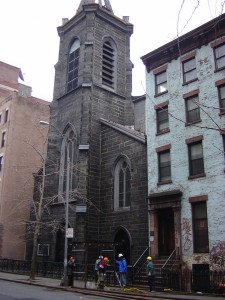Landmarking 101: Common Misconceptions

Last week we explained what a landmark is and how designation affects property owners. Today, we’ll try to dispel some of the inaccuracies and misconceptions about landmarking and historic preservation.
Myth #1: Landmarked buildings become frozen in time and cannot be altered
Not true, landmarked buildings can be changed. New York City landmarks can be altered in a number of ways – modern systems can be installed, extensions can be added and they can even be demolished. To make changes to a landmark the owner must get the approval of the Landmarks Preservation Commission. GVSHP has a webpage devoted to applications made to the Landmarks Preservation Commission to modify buildings in the Village.
While it is a significant honor, listing on the National Register of Historic Places does not impact an owner’s ability to make changes to the building unless they are using State or Federal funds to do so. The building can be altered or even demolished. To learn more about the difference between National Register listing and a New York City landmark, please see this post.
Myth #2: Landmarking reduces property values
No. Landmarking helps to retain unique architectural details and protect the special character of a neighborhood which makes an area and a building more desirable and ultimately more valuable. A number of studies have pointed to the increased resale value of buildings in historic districts when compared to similar buildings that are not designated. Many see the benefit of owning a property in an historic district because it is less likely that one’s property will be overshadowed by a large, overscale structure or that a new, unattractive building can be built nearby.
As an example, the former St. Ann’s Church (not landmarked) at 110-124 East 12th Street was demolished in 2005 by New York University to make way for a 26 story dormitory that permanently altered the cohesiveness and scale of the streetscape. To learn more about GVSHP’s efforts to halt these plans, please click here.


Myth #3: Landmark designation is designed to control what owners can to do their property
False. The creation of the Landmarks Law came about in response to the loss of significant historic structures. The goal of landmarking is to ensure that the fabric of the built environment that conveys part of our architectural, social and cultural history and development is protected so that it can be enjoyed by future generations.
It is important to point out that building owners are not free to do whatever they wish with their properties, landmarked or not. Department of Buildings regulations, zoning laws, the Fire Code and a number of other laws governs the occupancy, use, alteration and demolition of every structure in the City.
Myth #4: Landmarking only recognizes fancy, high style buildings
Wrong. Historic districts and landmarks are supposed to be representative of the collective American experience. Therefore, buildings that may appear “plain” or vernacular are recognized with designation because our history is marked not only by grand, high style buildings but also, simple homes and buildings from an important era in our history.
The refined ornament of Federal style buildings, constructed between 1790 and the early 1830s, is far less elaborate than later Victorian era buildings, yet they are no less significant. With only about 300 Federal era houses remaining in Lower Manhattan, GVSHP is engaged in documenting and preserving these rare and important buildings.
Myth #5: It is expensive to own a landmark designated property
Not necessarily. The only requirement of owners of landmarked properties is that they maintain their buildings in good repair. Owners should not assume that because their building is landmarked the costs to maintain and repair it will skyrocket. Generally, if an owner is capable of keeping a non-designated building in good condition they will also be able to do so if it is landmarked. Some repairs may be more expensive but, the long term benefit is that the materials and process are of a better quality and therefore will have a longer life.
Myth #6: Landmarking impedes progress and is not good for business
Not true. Businesses often thrive in historic districts because the distinct character of the area attracts more customers. Many businesses that would be priced out of newly constructed commercial space find that they are able to succeed and grow their businesses in historic districts. In addition, adaptive reuse of historic buildings is not only a more environmentally sustainable approach than new construction but it can also helped to revitalize neighborhoods.
